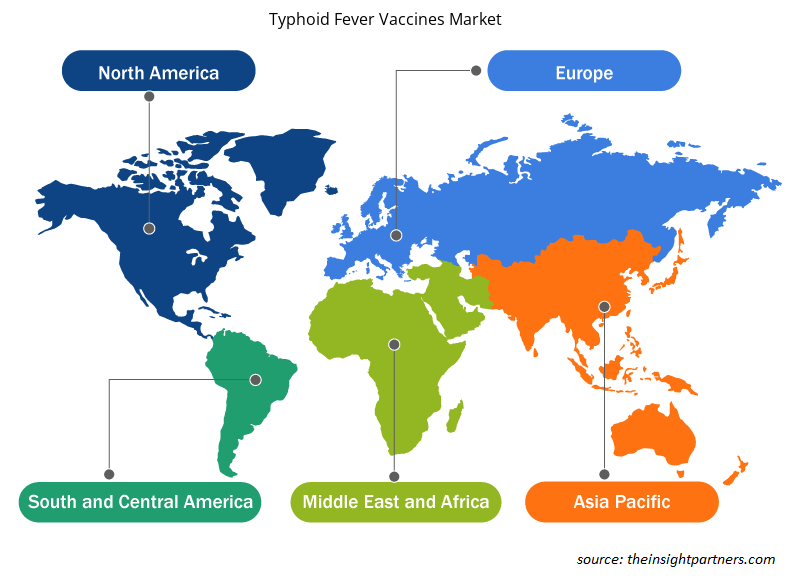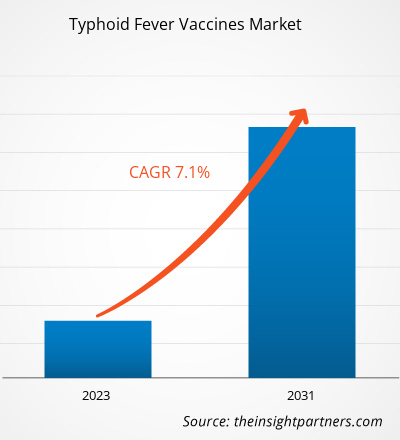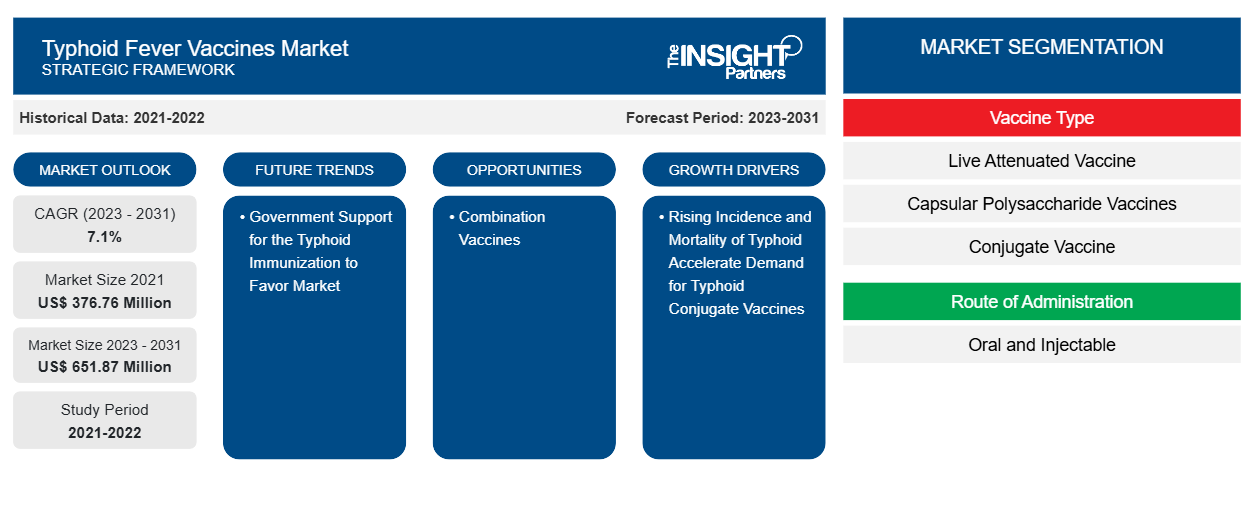Der Markt für Typhus-Impfstoffe wurde 2021 auf 376,76 Millionen US-Dollar geschätzt und soll bis 2031 651,87 Millionen US-Dollar erreichen. Der Markt soll von 2023 bis 2031 eine durchschnittliche jährliche Wachstumsrate von 7,1 % verzeichnen. Die Verbreitung kombinierter Typhus-Impfstoffe dürfte weiterhin ein wichtiger Trend auf dem Markt für Typhus-Impfstoffe bleiben.
Marktanalyse für Typhus-Impfstoffe
Steigende Inzidenz und Mortalität bei Typhus beschleunigen die Nachfrage nach Typhus-Konjugatimpfstoffen
Laut dem Bericht der Weltgesundheitsorganisation (WHO) vom März 2023 erkrankten im Jahr 2019 schätzungsweise 9 Millionen Menschen an Typhus, und jährlich sterben 110.000 Menschen an Typhus. Außerdem besteht für Reisende ein hohes Risiko, an Typhus zu erkranken, insbesondere in Asien und Afrika südlich der Sahara. Angesichts der steigenden Inzidenz und Todesfälle ist die Nachfrage nach Typhusimpfstoffen daher so hoch wie nie zuvor. Die WHO empfiehlt Ländern beispielsweise, eine Immunisierung mit Typhus-Konjugatimpfstoffen (TCV) durchzuführen, um die Krankheit in endemischen Regionen unter Kontrolle zu bringen. Der TCV ist der erste Typhusimpfstoff, der für Kinder ab sechs Monaten geeignet ist, und ist weltweit die am häufigsten bevorzugte Typhusimpfung. Das Global Vaccine Market Model (GVMM) schätzt, dass die gesamten Markteinnahmen für TCV in Ländern mit mittlerem Einkommen (MICs) und Ländern mit niedrigem Einkommen (LICs) schätzungsweise 44 Millionen US-Dollar erreichen, was einem Marktanteil von nur etwa 14 % entspricht.
Quelle: GVMM
Darüber hinaus hält das Kinderhilfswerk der Vereinten Nationen (UNICEF) einen Marktanteil von über 95 % bei TCV-Impfstoffen, insbesondere in Subsahara-Afrika sowie Süd- und Südostasien für LICs und MICs. UNICEF sorgt für die angemessene Versorgung mit TCV-Impfstoffen in Subsahara-Afrika sowie Süd- und Südostasien, um die hohe Zahl der Typhusfälle in der Bevölkerung zu reduzieren. Daher sind die steigende Prävalenz und Mortalität im Zusammenhang mit Typhus sowie die angemessene Nachfrage und Versorgung mit Typhus-Impfstoffen in Epidemieländern die Einflussfaktoren, die für das Wachstum des Marktes für Typhus-Impfstoffe in den Jahren 2021–2031 verantwortlich sind.
Marktübersicht für Typhus-Impfstoffe
Staatliche Eingriffe und intelligente Lösungen zur Impfstoffverabreichung beeinflussen die Typhusimpfungen weiterhin erheblich. Staatliche Unterstützung für die Typhusimpfung sowie die steigende Inzidenz und Mortalität von Typhus sind die einflussreichsten Faktoren, die für das Wachstum des Typhusimpfstoffmarktes verantwortlich sind. Kombinationsimpfstoffe gegen Typhus sind ein wichtiger Trend für das Wachstum des Typhusimpfstoffmarktes. Präklinische Studien zur Entwicklung eines trivalenten Typhus-/Nicht-Typhus-Salmonellen-Glykokonjugatimpfstoffs werden lukrative Marktchancen bieten.
Passen Sie diesen Bericht Ihren Anforderungen an
Sie erhalten kostenlos individuelle Anpassungen an jedem Bericht, einschließlich Teilen dieses Berichts oder einer Analyse auf Länderebene, eines Excel-Datenpakets sowie tolle Angebote und Rabatte für Start-ups und Universitäten.
-
Holen Sie sich die wichtigsten Markttrends aus diesem Bericht.Dieses KOSTENLOSE Beispiel umfasst eine Datenanalyse von Markttrends bis hin zu Schätzungen und Prognosen.
Typhus-ImpfstoffeMarkttreiber und ChancenVaccinesMarket Drivers and Opportunities
Staatliche Unterstützung für Typhus-Impfung fördert den Markt
Die staatliche Unterstützung der Typhusimpfung beschleunigt die weltweite Nachfrage nach Impfstoffen. So zeigt beispielsweise der Bericht des australischen Commonwealth, dass Kindern unter 2 Jahren und Erwachsenen eine Typhusimpfung empfohlen wird , wenn sie in epidemische Regionen wie Afrika südlich der Sahara sowie Süd- und Südostasien reisen. Außerdem können Kinder unter 2 Jahren und Erwachsene eine Dosis parenteralen Typhusimpfstoff erhalten, und Kinder über 6 Jahren und Erwachsene können drei oder vier Dosen oralen Typhusimpfstoffs erhalten.
Darüber hinaus ist in Kanada eine Typhusimpfung für Reisende über 2 Jahre, die nach Südasien reisen, darunter Afghanistan, Bangladesch, Bhutan, Indien, Malediven, Nepal, Pakistan und Sri Lanka, obligatorisch. Daher wird die staatliche Unterstützung des Typhus-Immunisierungsprogramms weiter dazu beitragen, dass der Markt für Typhus-Impfstoffe zwischen 2021 und 2031 exponentiell wächst.
Präklinische Studien zur Entwicklung eines trivalenten Typhus-/Nicht-Typhus-Salmonellen-Glykokonjugat-Impfstoffs – eine Chance
Im Februar 2024 gaben SK Bioscience und das International Vaccine Institute (IVI) bekannt, dass der von SK Bioscience entwickelte Typhus-Konjugatimpfstoff die WHO-Vorqualifikation (PQ) für die öffentliche Beschaffung des Impfstoffs durch die UN-Organisationen erhalten hat, was zu einem Anstieg der weltweiten TCV-Versorgung führte. Die Ergebnisse der klinischen Phase-2-Studie der Auffrischimpfung „SKYTYPHOID“ zeigen, dass die beiden Dosen des TCV bei Säuglingen im Alter von 6 bis 23 Monaten eine starke Immunreaktion hervorriefen.
Darüber hinaus entwickeln mehrere Hersteller TCVs, die sich im präklinischen Stadium befinden. Beispielsweise entwickeln Hersteller einen trivalenten Typhus-/Nicht-Typhus-Salmonella-Glykokonjugat-Impfstoff, insbesondere für die Bevölkerung in Afrika südlich der Sahara. Auch die Entwicklung eines Typhus- und Paratyphus-A-Impfstoffs auf Basis eines multiplen Antigen-präsentierenden Systems (MAPS) befindet sich noch im präklinischen Stadium und ist eine vielversprechende Alternative zum herkömmlichen Konjugatimpfstoff. Daher werden klinische Studien zur Entwicklung eines innovativen Typhus-Impfstoffs den Herstellern lukrative Marktchancen bieten, die letztlich den Markt für Typhus-Impfstoffe vorantreiben.
Impfstoffe gegen Typhus
Marktbericht-Segmentierungsanalyse
Wichtige Segmente, die zur Ableitung der Marktanalyse für Typhus-Impfstoffe beigetragen haben, sind Bewerbung und Dienstleistungen.
- Basierend auf dem Impfstofftyp ist der Markt für Typhus-Impfstoffe in Lebendimpfstoffe, Kapselpolysaccharidimpfstoffe, Konjugatimpfstoffe und andere unterteilt. Die Kapselpolysaccharidimpfstoffe könnten im Jahr 2023 einen größeren Marktanteil haben.
- Basierend auf der Verabreichungsmethode ist der Markt für Typhus-Impfstoffe in orale und injizierbare Impfstoffe unterteilt. Das injizierbare Segment könnte im Jahr 2023 einen größeren Marktanteil haben.
Marktanteilsanalyse für Typhus-Impfstoffe nach geografischen Gesichtspunkten
Der geografische Umfang des Marktberichts zu Typhus-Impfstoffen ist hauptsächlich in fünf Regionen unterteilt: Nordamerika, Asien-Pazifik, Europa, Naher Osten und Afrika sowie Südamerika/Süd- und Mittelamerika.
Nordamerika dominiert den Markt für Typhus-Impfstoffe. In Nordamerika haben die USA einen beträchtlichen Anteil an Typhus-Impfstoffen. Nordamerika hat den größten Marktanteil bei Typhus-Impfstoffen und die Einnahmen aufgrund steigender Gesundheitsausgaben und der Entwicklung innovativer Impfstoffe durch klinische Studien sind die einflussreichsten Faktoren für das Marktwachstum. Der asiatisch-pazifische Raum wird in den kommenden Jahren voraussichtlich die höchste durchschnittliche jährliche Wachstumsrate aufweisen.
Impfstoffe gegen Typhus
Regionale Einblicke in den Markt für Typhus-Impfstoffe
Die regionalen Trends und Faktoren, die den Markt für Typhus-Impfstoffe während des Prognosezeitraums beeinflussen, wurden von den Analysten von Insight Partners ausführlich erläutert. In diesem Abschnitt werden auch die Marktsegmente und die Geografie von Typhus-Impfstoffen in Nordamerika, Europa, im asiatisch-pazifischen Raum, im Nahen Osten und Afrika sowie in Süd- und Mittelamerika erörtert.

- Erhalten Sie regionale Daten zum Markt für Typhus-Impfstoffe
Umfang des Marktberichts zu Typhus-Impfstoffen
| Berichtsattribut | Details |
|---|---|
| Marktgröße im Jahr 2021 | 376,76 Millionen US-Dollar |
| Marktgröße bis 2031 | 651,87 Millionen US-Dollar |
| Globale CAGR (2023 - 2031) | 7,1 % |
| Historische Daten | 2021-2022 |
| Prognosezeitraum | 2023–2031 |
| Abgedeckte Segmente |
Nach Impfstofftyp
|
| Abgedeckte Regionen und Länder |
Nordamerika
|
| Marktführer und wichtige Unternehmensprofile |
|
Marktteilnehmerdichte für Typhus-Impfstoffe: Auswirkungen auf die Geschäftsdynamik verstehen
Der Markt für Typhus-Impfstoffe wächst rasant, angetrieben durch die steigende Nachfrage der Endverbraucher aufgrund von Faktoren wie sich entwickelnden Verbraucherpräferenzen, technologischen Fortschritten und einem größeren Bewusstsein für die Vorteile des Produkts. Mit steigender Nachfrage erweitern Unternehmen ihr Angebot, entwickeln Innovationen, um die Bedürfnisse der Verbraucher zu erfüllen, und nutzen neue Trends, was das Marktwachstum weiter ankurbelt.
Die Marktteilnehmerdichte bezieht sich auf die Verteilung der Firmen oder Unternehmen, die in einem bestimmten Markt oder einer bestimmten Branche tätig sind. Sie gibt an, wie viele Wettbewerber (Marktteilnehmer) in einem bestimmten Marktraum im Verhältnis zu seiner Größe oder seinem gesamten Marktwert präsent sind.
Die wichtigsten auf dem Markt für Typhus-Impfstoffe tätigen Unternehmen sind:
- Indische Immunologie
- LBIP
- Finlay
- Incepta
- Allheilmittel
- Bharat Biotech
Haftungsausschluss : Die oben aufgeführten Unternehmen sind nicht in einer bestimmten Reihenfolge aufgeführt.

- Überblick über die wichtigsten Akteure auf dem Markt für Typhus-Impfstoffe
Impfstoffe gegen TyphusMarktnachrichten und aktuelle Entwicklungen
Der Markt für Typhus-Impfstoffe wird durch die Erhebung qualitativer und quantitativer Daten nach Primär- und Sekundärforschung bewertet, die wichtige Unternehmensveröffentlichungen, Verbandsdaten und Datenbanken umfasst. Im Folgenden finden Sie eine Liste der Entwicklungen auf dem Markt für Typhus-Impfstoffe und Strategien:
- Im November 2023 kündigte die Republik Korea an, dass ein neuer Typhus-Impfstoffkonjugat, „Bio-TCV Typhus-Konjugatimpfstoff (TCV)“, in Indonesien zugelassen werden soll, nachdem die nationale Regulierungsbehörde Badan Pengawas Obat dan Makanan (BPOM) die Marktzulassung erteilt hat. Der neue Impfstoff „Bio-TCV“ ist ein Vi-Polysaccharid-Konjugatimpfstoff.
Marktbericht zu Typhus-Impfstoffen - Umfang und Ergebnisse
Der Bericht „Marktgröße und Prognose für Typhus-Impfstoffe (2021–2031)“ bietet eine detaillierte Analyse des Marktes, die die folgenden Bereiche abdeckt:
- Marktgröße und Prognose auf globaler, regionaler und Länderebene für alle wichtigen Marktsegmente, die im Rahmen des Projekts abgedeckt sind
- Marktdynamik wie Treiber, Beschränkungen und wichtige Chancen
- Wichtige Zukunftstrends
- Detaillierte PEST/Porters Five Forces- und SWOT-Analyse
- Globale und regionale Marktanalyse mit wichtigen Markttrends, wichtigen Akteuren, Vorschriften und aktuellen Marktentwicklungen
- Branchenlandschaft und Wettbewerbsanalyse, einschließlich Marktkonzentration, Heatmap-Analyse, prominenten Akteuren und aktuellen Entwicklungen
- Detaillierte Firmenprofile
- Historische Analyse (2 Jahre), Basisjahr, Prognose (7 Jahre) mit CAGR
- PEST- und SWOT-Analyse
- Marktgröße Wert/Volumen – Global, Regional, Land
- Branchen- und Wettbewerbslandschaft
- Excel-Datensatz
Aktuelle Berichte
Erfahrungsberichte
Grund zum Kauf
- Fundierte Entscheidungsfindung
- Marktdynamik verstehen
- Wettbewerbsanalyse
- Kundeneinblicke
- Marktprognosen
- Risikominimierung
- Strategische Planung
- Investitionsbegründung
- Identifizierung neuer Märkte
- Verbesserung von Marketingstrategien
- Steigerung der Betriebseffizienz
- Anpassung an regulatorische Trends























 Kostenlose Probe anfordern für - Markt für Typhus-Impfstoffe
Kostenlose Probe anfordern für - Markt für Typhus-Impfstoffe